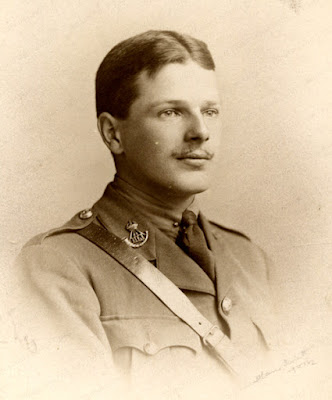 |
| D/DLI 7/560/8 Map of Contalmaison area with annotations by Second Lieutenant Frederick Rees, 1916 |
Among the letters, diaries, photos and official papers that make up the Durham Light Infantry’s archive, catalogued and cared for by Durham County Record Office, is a stained and faded trench map printed in late July 1916 of part of the Somme battlefield north of Contalmaison. Trenches and belts of barbed wire are printed in red, but other pencil and ink lines have then been added by hand.
This map is easily overlooked, but look closely and it becomes an evocative reminder of the severity of the fighting on the Somme that lasted throughout the long summer and autumn of 1916.
Towards the top of the map is a particularly worn spot surrounding a small circle drawn in pencil and numbered ‘41’. Here too the trenches, including part of Munster Alley, have been over-drawn in pencil, for the simple reason that dirty fingers have rubbed and smudged the original printed lines.
At this point ‘41’, during the night of 4/5 August 1916, a young officer, Second Lieutenant Frederick Rees, and soldiers of B Company 13th Battalion DLI fought a desperate battle. In the long hours of fighting, this map must have been examined and point ‘41’ touched over and over again by Rees and his sergeants.
The fighting had begun about 9:15pm on 4 August, when 13 DLI’s four companies attacked towards German-held Torr Trench and Munster Alley. From point ‘41’, Rees led B Company’s bombers up Munster Alley for 60 yards, taking five prisoners, before a German barricade, heavily defended by barbed wire and two machine guns, halted the advance. B Company then hastily made its own barricade little more than 50 feet from the German position and held on all night in spite of repeated attacks.
During that night, Rees received what he later described in a letter to his mother as “a nice cushy little wound” [D/DLI 7/560/6(1)]. Other 13 DLI soldiers, however, were not so fortunate and over 120 were killed, wounded or reported missing in the fighting, including Rees’ friend, the composer Lieutenant George Butterworth, killed by a sniper on 5 August.
 |
| D/DLI 7/560/12 Second Lieutenant Frederick Rees |
In the late 1970s, I had the pleasure of meeting Frederick Rees twice, when he visited the DLI Museum. On the second occasion, I was just about to run through a 16mm film ‘The Battle of Ancre and Advance of the Tanks’ that I had hired from the Imperial War Museum. I used to hire this film (in those long ago days before videos, DVDs, etc.) to show to secondary school groups visiting the museum. As the film was silent, I used to give a running commentary and I was just rehearsing my lines, when Frederick Rees arrived unannounced.
So, that afternoon, we sat, and drank tea, and watched the hour long film together in my office. He had never seen the film before and he talked about what was happening on the screen, about places on the Somme he had visited, about the tanks, about the DLI, about himself and about the friends he had lost over 60 years before. For me, it was an incredible afternoon but all that remains after 40 years are my fading memories, as sadly in those days the museum had no way of recording what this old soldier was saying. After Frederick Rees, however, any other DLI Great War veterans I met or became aware of were quickly reported to the Imperial War Museum and interviewed for the IWM’s oral history project.
Frederick Llewellyn Forsaith Rees
Born in Barmby Moor, near York, in 1891, Frederick was commissioned as a Second Lieutenant in the Durham Light Infantry in February 1915. He saw action on the Western Front and in Italy with the 13th Battalion and was wounded twice in August 1916 and October 1918.
Before the war, Frederick had studied theology at Durham University (where he had also been a member of the Officer Training Corps). In 1919, he returned to his theological studies and was ordained a priest in 1922. He then worked in several parishes in Nottinghamshire until his retirement.
After Frederick Rees died in 1983, his medals (including the Military Cross he had been awarded for his bravery on the Somme in August 1916), letters, photographs, maps, and other items were presented to the DLI Museum by his son. The letters, photographs, and maps are now part of the regimental archive at Durham County Record Office. The DLI medal collection is moving to Durham University Library on Palace Green, close to the DLI memorial chapel, in October 2016.

No comments:
Post a Comment